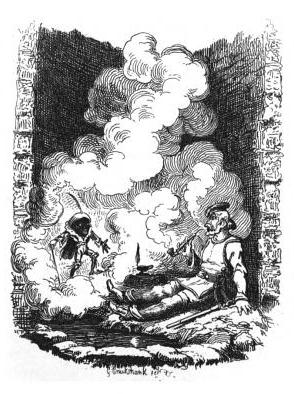John Ruskin was just ten years old when he wrote and illustrated The Puppet Show: Or, Amusing Characters for Children. The little book is filled with twenty-nine short poems, each of which is accompanied by two pen-and-ink drawings. The poems, as far as I can determine, are Ruskin's own, although some of the illustrations are copied from George Cruikshank's vignettes in Grimm's German Popular Stories (London, 1823). Here we have "The Old Fairy:"

The top illustration is clearly from Cruikshank's engraving for Grimm's "Jorinda and Jorindel," shown here:

This is the story of a fairy (beautiful by day, but an old woman once night falls) who has turned 700 young women into birds, which she keeps individually caged in her castle. Jorinda, who was "prettier than all the pretty girls that ever was seen" is turned into a nightingale before her lover Jorindel. This scene comes at the end of the tale, just at the moment when Jorindel uses an enchanted flower to restore Jorinda to her human form. The story does not give physical descriptions of the characters beyond the generic "beautiful" and "pretty,"and while Ruskin's poem is not drawn from the story it nevertheless echoes and perhaps further develops the character of Grimm's fairy. He has taken the old fairy's ill-will and added scarlet to her cloak and picked up on her "staring eyes" and "parrot nose."
The unrelated Water Kelpie that appears below the poem is perhaps one of my favorite illustrations in the book:

The Kelpie, which traditionally takes the form of a horse, is a creature native to the Scottish and Irish rivers and lochs that lures children into the water to drown them. I'm not sure of his relationship to Ruskin's old fairy, but check out those eye-rays!
A few pages later, Ruskin's "The Dwarf" appears:

This poem and accompanying illustrations are even more clearly derived from Grimm's "The Blue Light" and Cruikshank's vignette:

I love Ruskin's delicate coloring and his enthusiastic shading of the clouds, and it is a pretty successful rendition, especially for a 10-year old.

Ruskin's appreciation for Cruikshank's engravings was enduring. When, long established as an art critic, he wrote the introduction to a later edition of Grimm's German Popular Stories (1868), Ruskin called Cruikshank's illustrations "quite sterling and admirable art, in a class precisely parallel in elevation to the character of the tales which they illustrate; and the original etchings as I have before said in the Appendix to my Elements of Drawing were unrivalled in masterfulness of touch since Rembrandt; (in some qualities of delineation unrivalled even by him)."
For more information about Ruskin's The Puppet Show, click here.
The Leon Levy Foundation is generously underwriting a major project to upgrade catalog records for the Morgan's collection of literary and historical manuscripts. The project is the most substantive effort to date to improve primary research information on a portion of this large and highly important collection.
